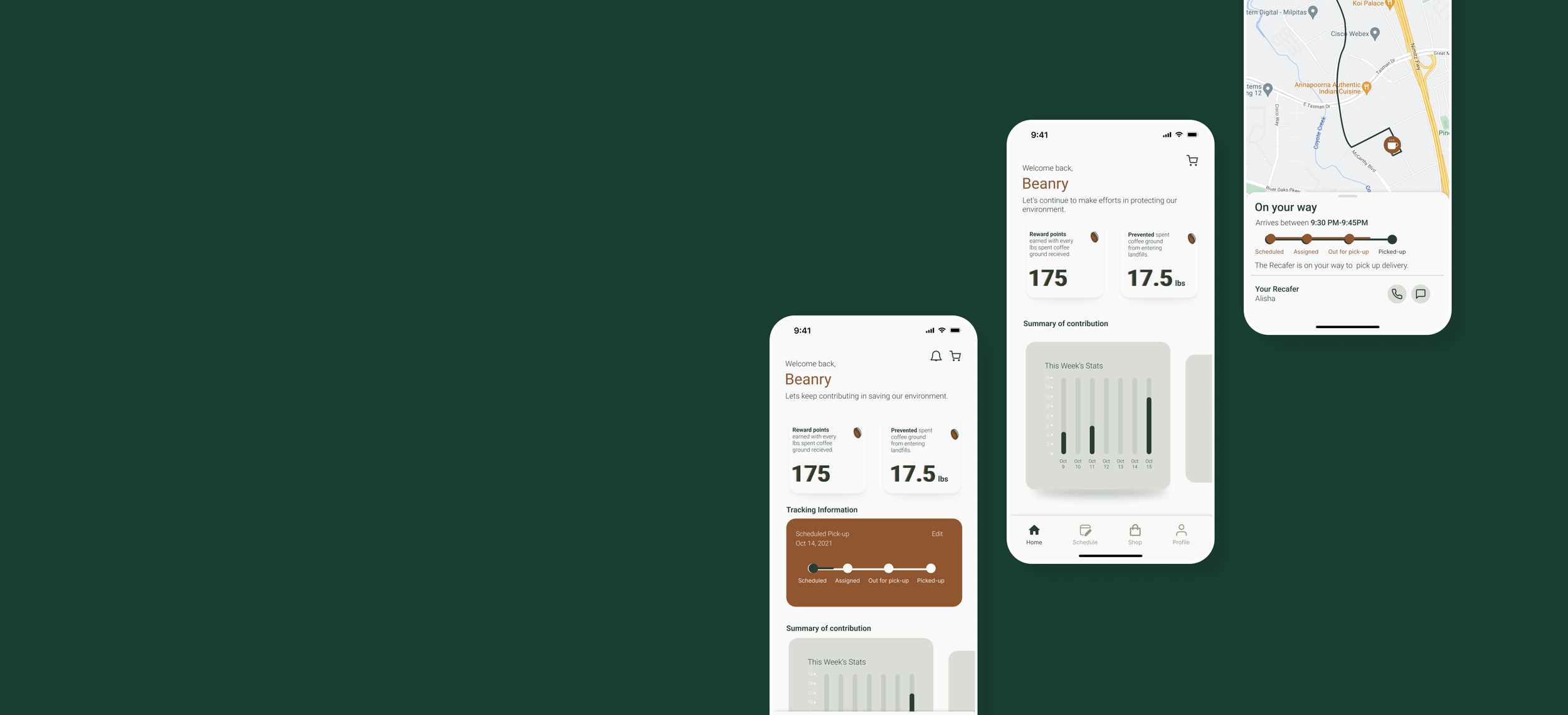
recaf
Turning coffee waste into rewards, effortlessly.
Recaf
A mobile application designed to assist small coffee shops in managing and storing spent coffee grounds, with the aim of recycling them effectively.
My Role
Solo Project
Duration
2 weeks project
Industry
Design for sustainability
Project Brief
Propose, design, and create a mockup of a mobile app that creatively leverages the unique capabilities of smartphones to address sustainability challenges faced by a specific professional group. The app’s core interactions should be both personally meaningful to users and objectively impactful from a climate science perspective.
The Context
Coffee is a daily ritual for many, whether it's a quick cup before work or a leisurely weekend brew. But with every cup of coffee we enjoy, we’re left with spent coffee grounds—an often overlooked byproduct. These grounds typically end up in the trash, joining heaps of waste in landfills. What many don’t realize is that as these grounds decompose, they release methane, a greenhouse gas that’s far more potent than carbon dioxide. Methane's ability to trap heat in the atmosphere is 25 times greater over a century, making it a serious contributor to global warming.
In talking with coffee enthusiasts, one person mentioned-
'“I love my morning coffee, but I never really thought about what happens to the grounds afterward. It’s kind of alarming to realize something so small could have such a big impact on the environment.”
The Challenge
How can small coffee shop owners effectively manage waste while finding sustainable solutions for spent coffee grounds with the financial constraints of running a business?
The Solution
A mobile application that simplifies the collection and recycling of used coffee grounds for small cafes and shops. By allowing store owners to easily schedule pickups, Recaf not only streamlines waste management but also incentivizes participation through a rewards system. Each successful pickup earns coffee shops points that can be redeemed for innovative products made from coffee waste, fostering a community focused on sustainability without added complexity.
Design Process
Let’s take a quick stroll through the design journey. From identifying user challenges to sketching concepts and fine-tuning the final product, here’s a behind-the-scenes glimpse if you’re ready to explore the details!
Reserach
Each year, around 18 million tonnes of used coffee grounds end up in landfills, with a substantial portion originating from coffee shops. Disposing of these grounds in landfills can result in the release of methane, a greenhouse gas that is significantly more potent than CO2 and contributes to climate change. Given the high volume of coffee consumed daily, it’s no surprise that coffee shops generate a large amount of waste. The environmental footprint of producing a single cup of coffee is considerable, yielding approximately 14 grams of waste per serving. This highlights the daily waste production from these establishments.
To delve deeper into this issue, I conducted semi-structured interviews to explore how cafes and coffee shops currently manage the disposal of used coffee grounds and identify their needs in this area. Here are the key insights gathered:
Insights Gained
Define
By creating a user persona from the insights gathered during my research allowed me to identify the specific problem that requires attention. This persona provided a clear lens through which to view the challenges our users encounter, guiding me in developing effective solutions tailored to their needs.
Ideate
I looked into how the market is tackling the coffee waste problem. Kaffeeform, a Berlin startup, makes cups from used coffee grounds, collected by bike couriers from cafés and roasters. Bio-bean, a UK company, collects spent grounds from various businesses and repurposes them into coffee logs and pallets. Starbucks' Grounds for Your Garden offers free used coffee grounds for composting, reusing the original bean bags for distribution. This sparked my ideation towards creating a solution focused on small coffee shops and efficient recycling methods.
User Flow
Information Architecture
Design
I focused on translating my ideas into wireframes and final designs that address the sustainability challenges faced by small coffee shops. The wireframes illustrate the app's core features, including scheduling pickups and tracking rewards. As I moved to the final design, I ensured a user-friendly interface that simplifies the recycling process for shop owners.
To bring the design to life, I used p5.js, a JavaScript library, to build the application's interactive elements, ensuring a seamless user experience.
Wireframes
Final Screens
Learnings
Research Methods: I gained practical experience in conducting semi-structured interviews, which provided rich qualitative data and revealed deeper insights into user behavior and needs.
The Impact of Sustainable Practices: This project deepened my understanding of the environmental implications of coffee waste and highlighted the significant role small businesses can play in promoting sustainability.
Research-Driven Insights: Conducting thorough desk research and interviews provided valuable insights, but I recognized that direct user testing is essential for refining designs and understanding real-world applications.
Flexibility in Design Thinking: The project taught me to stay flexible and adaptive. Without user feedback, I had to rely on my assumptions and research, reinforcing the idea that design is an ongoing, evolving process.











